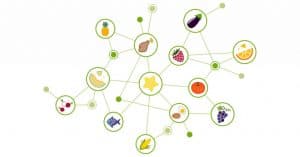
Do you experience GI distress during your workouts? FODMAPs may be the source. The FODMAP diet has been scientifically proven to reduce symptoms in patients suffering from IBS and has been shown in small studies to be effective in reducing GI symptoms in endurance athletes.
What are FODMAPs?
Fermentable Oligo-, Di-, Monosaccharides, and Polyols, or FODMAPs, are types of carbohydrates most people have a hard time digesting. Oligosaccharides (and Fructans) are found in wheat, rye, onion, garlic, legumes, and pulses. Disaccharides include lactose, or the sugar found in dairy products. Monosaccharides are found in honey, high fructose corn syrup, and many fruits and veggies including watermelon, apples, cherries, figs, pears, peaches, and plums. Finally, polyols are sugar alcohols such as sorbitol and mannitol found naturally in fruits, vegetables, and artificial sweeteners.
FODMAPs and GI Distress
So how do these foods affect our GI system? These specific types of carbohydrates are not digested and absorbed as well as other sugars, causing them to pass through to the large intestine mostly intact. FODMAPs pull water into the large intestine causing diarrhea. The bacteria in our gut then ferments FODMAPs which produces gas, bloating, constipation, and pain.
Low FODMAP Diet
Following a FODMAP diet, however, is very restrictive, and may not be necessary to provide some benefit. FODMAPs include common gut irritants such as wheat and lactose, so it may be as simple to trying to reduce foods containing wheat and dairy before, during, and after workouts. But if you’ve tried this already and your symptoms persist, it may be a good idea to try a FODMAP trial.
- The Elimination Phase is 2-6 weeks. A low FODMAP diet (eliminating all high FODMAP foods) is followed to allow the body to reset. See this link for a list of high and low FODMAP foods.
- The Challenge Phase is 8-12 weeks. Foods high in FODMAPs will be reintroduced into the diet food by food. Allow at least three days before trying another food. Note the type of food and quantity along with any symptoms.
- The Integration Phase allows you to add back tolerable high FODMAP foods in tolerable amounts. For example, you may be able to eat dairy again, but only one serving a day. It’s likely that you will need to retest foods over time as our bodies adapt and change.
Alternative Ways to Lower FODMAPs
Following the full FODMAP diet protocol is time-consuming and intense, and might be necessary for extreme cases of GI distress or those suffering from IBS or other GI disorders. But fret not –
you can still make this diet work for you in the short term if you experience GI discomfort during workouts.
You may find that only a few categories or even a few foods cause GI discomfort and can avoid those when your training gets more intense or the weeks surrounding competition.
For example, you may find that apples cause GI discomfort or that you can’t consume too many servings of sweet potatoes in a week. It may take some trial and error, listening to your body, and making note of foods you eat when symptoms surface.
If you think you may need to try a low FODMAP diet for GI discomfort during exercise or suspect that you have a GI disorder, schedule a consult or appointment with the Elite Sports Club dietitian, Sarah Brunner. She will help you navigate the FODMAP diet to best fit your needs and goals. Your initial consultation with Elite Dietitians and Nutritionists is free for members; get on your way to a healthier you with the experts at Elite Sports Clubs.
Schedule a Nutrition Consultation